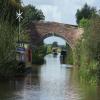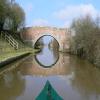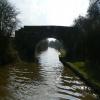
Nixon's Bridge No 114 
Address is taken from a point 2031 yards away.

Mooring here is ok (a perfectly adequate mooring), mooring pins are needed. The linear moorings currently (Oct. 2011) extend from here for over 1.25 miles (2 km) to about halfway between bridges 115 & 116.
There is a bridge here which takes a track over the canal.
| Duttons Bridge No 112 | 1 mile | |
| Tattenhall Marina | 5 furlongs | |
| Tattenhall Visitor Moorings (Crows Nest) | 4½ furlongs | |
| Crows Nest Bridge Winding Hole | 4 furlongs | |
| Crows Nest Bridge No 113 | 3¾ furlongs | |
| Nixon's Bridge No 114 | ||
| Golden Nook Farm Moorings | 5½ furlongs | |
| Golden Nook Bridge No 115 | 5¾ furlongs | |
| Faulkner's Bridge No 116 | 1 mile, 6½ furlongs | |
| Salmons Bridge No 117 | 2 miles, 1½ furlongs | |
| Davies Bridge No 118 | 2 miles, 4¼ furlongs | |
Amenities nearby at Crows Nest Bridge No 113
The linear moorings currently (Oct. 2011) extend from here for
over 1.25 miles (2 km) to about halfway between bridges 115 &
116.
This makes for considerably slower progress than normal.
Why not log in and add some (select "External websites" from the menu (sometimes this is under "Edit"))?
Mouseover for more information or show routes to facility
Nearest water point
In the direction of Winding Hole above Bunbury Locks
In the direction of River Dee Branch Junction
Nearest rubbish disposal
In the direction of Winding Hole above Bunbury Locks
In the direction of River Dee Branch Junction
Nearest chemical toilet disposal
In the direction of Winding Hole above Bunbury Locks
In the direction of River Dee Branch Junction
Nearest place to turn
In the direction of Winding Hole above Bunbury Locks
In the direction of River Dee Branch Junction
Nearest self-operated pump-out
In the direction of Winding Hole above Bunbury Locks
In the direction of River Dee Branch Junction
Nearest boatyard pump-out
In the direction of Winding Hole above Bunbury Locks
In the direction of River Dee Branch Junction
Wikipedia has a page about Nixon's Bridge
Richard Milhous Nixon (January 9, 1913 – April 22, 1994) was the 37th president of the United States, serving from 1969 to 1974. A member of the Republican Party, Nixon previously served as the 36th vice president from 1953 to 1961, having risen to national prominence as a representative and senator from California. After five years in the White House that saw the conclusion to the U.S. involvement in the Vietnam War, détente with the Soviet Union and China, and the establishment of the Environmental Protection Agency, he became the only president to resign from the office, following the Watergate scandal.
Nixon was born into a poor family of Quakers in a small town in Southern California. He graduated from Duke University School of Law in 1937 and returned to California to practice law. He and his wife Pat moved to Washington in 1942 to work for the federal government. He served on active duty in the Navy Reserve during World War II. He was elected to the House of Representatives in 1946. His pursuit of the Hiss Case established his reputation as a leading anti-Communist which elevated him to national prominence. In 1950, he was elected to the Senate. He was the running mate of Dwight D. Eisenhower, the Republican Party's presidential nominee in the 1952 election, subsequently serving for eight years as the vice president. He unsuccessfully ran for president in 1960, narrowly losing to John F. Kennedy. Nixon then lost a race for governor of California to Pat Brown in 1962. In 1968, he ran for the presidency again and was elected, defeating Hubert Humphrey and George Wallace in a close election.
Nixon ended American involvement in Vietnam in 1973, ending the military draft that same year. Nixon's visit to China in 1972 eventually led to diplomatic relations between the two nations, and he gained the Anti-Ballistic Missile Treaty with the Soviet Union the same year. His administration generally transferred power from federal control to state control. He imposed wage and price controls for 90 days, enforced desegregation of Southern schools, established the Environmental Protection Agency, and began the War on Cancer. He also presided over the Apollo 11 Moon landing, which signaled the end of the Space Race. He was re-elected in one of the largest electoral landslides in American history in 1972 when he defeated George McGovern.
In his second term, Nixon ordered an airlift to resupply Israeli losses in the Yom Kippur War, a war which led to the oil crisis at home. By late 1973, Watergate escalated, costing Nixon much of his political support. On August 9, 1974, facing almost certain impeachment and removal from office, he became the first American president to resign. Afterwards, he was issued a pardon by his successor, Gerald Ford. In 20 years of retirement, Nixon wrote his memoirs and nine other books and undertook many foreign trips, rehabilitating his image into that of an elder statesman and leading expert on foreign affairs. He suffered a debilitating stroke on April 18, 1994, and died four days later at age 81. Surveys of historians and political scientists have ranked Nixon as a below-average president. However, evaluations of him have proven complex, with successes as president contrasted against the circumstances of his departure from office.




















